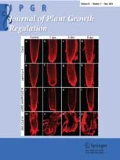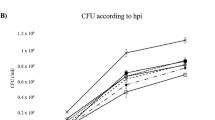Abstract
Harpin protein enhances plant disease resistance by activating PAMP-induced immunity. In this study, applications of harpin enhanced the efficiency of photosystem II, resulting in an increase in the fresh weights of Phalaenopsis orchids. A transcriptomic study of these harpin-treated Phalaenopsis orchids revealed that the application of harpin activated the expression of genes involved in nitric oxide (NO) generation, secondary metabolite production and plant responses, including responses to biotic, light stress, senescence, and hypoxia stimuli. Moreover, exposure to harpin induced the expression of a nitrate transporter and different members of the jasmonic acid resistance family. A proteomic study indicated that harpin applications increased protein accumulation in Phalaenopsis leaf tissues, including the accumulations of Cu/Zn superoxide dismutase (CSD2), pathogenesis-related protein 2, plasma membrane H+-ATPase, and protochlorophyllide oxidoreductase. In summary, this study demonstrates the effects of harpin on defense activation and growth promotion in Phalaenopsis orchids at both the physiological and molecular levels. Moreover, our study demonstrates that harpin modulates plant gene expression, most likely through its effects on reactive oxygen species (ROS), NO, and jasmonic acid signaling pathways.




Similar content being viewed by others
References
Akbudak N, Tezcan H, Akbudak B, Seniz V (2006) The effect of harpin protein on plant growth parameters, leaf chlorophyll, leaf colour and percentage rotten fruit of pepper plants inoculated with Botrytis cinerea. Sci Hortic 109:107–112
Allègre M, Héloir MC, Trouvelot S, Daire X, Pugin A, Wendehenne D, Adrian M (2009) Are grapevine stomata involved in the elicitor-induced protection against downy mildew? Mol Plant Microbe Interact 22:977–986
Bachem CW, van der Hoeven RS, de Bruijn SM, Vreugdenhil D, Zabeau M, Visser RG (1996) Visualization of differential gene expression using a novel method of RNA fingerprinting based on AFLP: analysis of gene expression during potato tuber development. Plant J 9:745–753
Blume B, Nurnberger T, Nass N, Scheel D (2000) Receptor-mediated increase in cytoplasmic free calcium required for activation of pathogen defense in parsley. Plant Cell 12:1425–1440
Boller T (1995) Chemoperception of microbial signals in plant cells. Annu Rev Plant Physiol Plant Mol Biol 46:189–214
Bourque S, Lemoine R, Sequeira-Legrand A, Fayolle L, Delrot S, Pugin A (2003) The elicitor cryptogein blocks glucose transport in tobacco cells. Plant Physiol 130:2177–2187
Chang X, Heene E, Qiao F, Nick P (2011) The phytoalexin resveratrol regulates the initiation of hypersensitive cell death in Vitis cell. PLoS One 6:e26405
Che YZ, Li YR, Zou HS, Zou LF, Zhang B, Chen GY (2011) A novel antimicrobial protein for plant protection consisting of a Xanthomonas oryzae harpin and active domains of cecropin A and melittin. Microb Biotechnol 4:777–793
Chen L, Qian J, Qu S, Long J, Yin Q, Zhang C, Wu X, Sun F, Wu T, Hayes M (2008) Identification of specific fragments of HpaG Xooc, a harpin from Xanthomonas oryzae pv. oryzicola, that induce disease resistance and enhance growth in plants. Phytopathology 98:781–791
Chuang HW, Harnrak A, Chen YC, Hsu CM (2010) A harpin-induced ethylene-responsive factor regulates plant growth and responses to biotic and abiotic stresses. Biochem Biophys Res Commun 402:414–420
Crawford NM (1995) Nitrate: nutrient and signal for plant growth. Plant Cell 7:859–868
Creelman RA, Mullet JE (1997) Biosynthesis and action of jasmonates in plants. Annu Rev Plant Physiol Plant Mol Biol 48:355–381
Doares SH, Syrovets T, Weiler EW, Ryan CA (1995) Oligogalacturonides and chitosan activate plant defensive genes through the octadecanoid pathway. Proc Natl Acad Sci 92:4095–4098
Dong H, Delaney TP, Bauer DW, Beer SV (1999) Harpin induces disease resistance in Arabidopsis through the systemic acquired resistance pathway mediated by salicylic acid and the NIM1 gene. Plant J 20:207–215
Dong HP, Peng J, Bao Z, Meng X, Bonasera JM, Chen G, Beer SV, Dong H (2004) Downstream divergence of the ethylene signaling pathway for harpin-stimulated Arabidopsis growth and insect defense. Plant Physiol 136:3628–3638
Dong HP, Yu H, Bao Z, Guo X, Peng J, Yao Z, Chen G, Qu S, Dong H (2005) The ABI2-dependent abscisic acid signalling controls HrpN-induced drought tolerance in Arabidopsis. Planta 221:313–327
Engelhardt S, Lee J, Gäbler Y, Kemmerling B, Haapalainen ML, Li CM, Wei Z, Keller H, Joosten M, Taira S (2009) Separable roles of the Pseudomonas syringae pv. phaseolicola accessory protein HrpZ1 in ion-conducting pore formation and activation of plant immunity. Plant J 57:706–717
Farouk S, Osman MA (2011) The effect of plant defense elicitors on common bean (Phaseolus vulgaris L.) growth and yield in absence or presence of spider mite (Tetranychus urticae Koch) infestation. J Stress Physiol & Biochem 7:5–22
Gorlach J, Raesecke HR, Rentsch D, Regenasst M, RoYP Zala M, Keel C, Boller T, Amrhein N, Schmid J (1995) Temporally distinct accumulation of transcripts encoding enzymes of the prechorismate pathway in elicitor-treated, cultured tomato cells. Proc Natl Acad Sci USA 92:3166–3170
Guan X, Buchholz G, Nick P (2013) The cytoskeleton is disrupted by the bacterial effector HrpZ, but not by the bacterial PAMP flg22, in tobacco BY-2 cells. J Exp Bot 64:1805–1816
Haapalainen M, Engelhardt S, Küfner I, Li CM, Nürnberger T, Lee J, Romantschuk M, Taira S (2011) Functional mapping of harpin HrpZ of Pseudomonas syringae reveals the sites responsible for protein oligomerization, lipid interactions and plant defence induction. Mol Plant Pathol 12:151–166
Heddad M, Adamska I (2000) Light stress-regulated two-helix proteins in Arabidopsis thaliana related to the chlorophyll a/b-binding gene family. Proc Natl Acad Sci USA 97:3741–3746
Huang YC, Chang YL, Hsu JJ, Chuang HW (2008) Transcriptome analysis of auxin-regulated genes of Arabidopsis thaliana. Gene 420:118–124
Kang JH, Wang L, Giri A, Baldwin IT (2006) Silencing threonine deaminase and JAR4 in Nicotiana attenuata impairs jasmonic acid-isoleucine-mediated defenses against Manduca sexta. Plant Cell 18:3303–3320
Kessler A, Baldwin IT (2001) Defensive function of herbivore-induced plant volatile emissions in nature. Science 291:2141–2144
Koers S, Guzel-Deger A, Marten I, Roelfsema MR (2011) Barley mildew and its elicitor chitosan promote closed stomata by stimulating guard-cell S-type anion channels. Plant J 68:670–680
Kottapalli KR, Satoh K, Rakwal R, Shibato J, Doi K, Nagata T, Kikuchi S (2007) Combining in silico mapping and arraying: an approach to identifying common candidate genes for submergence tolerance and resistance to bacterial leaf blight in rice. Mol Cells 24:394–408
Krause M, Durner J (2004) Harpin inactivates mitochondria in Arabidopsis suspension cells. Mol Plant Microbe Interact 17:131–139
Kunkel BN, Brooks DM (2002) Cross talk between signaling pathways in pathogen defense. Curr Opin Plant Biol 5:325–331
Kvitko BH, Ramos AR, Morello JE, Oh HS, Collmer A (2007) Identification of harpins in Pseudomonas syringae pv. tomato DC3000, which are functionally similar to HrpK1 in promoting translocation of type III secretion system effectors. J Bacteriol 189:8059–8072
Lee J, Klessig DF, Nurnberger T (2001) A harpin binding site in tobacco plasma membranes mediates activation of the pathogenesis-related gene HIN1 independent of extracellular calcium but dependent on mitogen-activated protein kinase activity. Plant Cell 13:1079–1093
Li W, Shao M, Zhong W, Yang J, Okada K, Yamane H, Zhang L, Wang G, Wang D, Xiao S (2012) Ectopic expression of Hrf1 enhances bacterial resistance via regulation of diterpene phytoalexins, silicon and reactive oxygen species burst in rice. PLoS One 7:e43914
Li X, Han L, Zhao Y, You Z, Dong H, Zhang C (2014) Hpa1 harpin needs nitroxyl terminus to promote vegetative growth and leaf photosynthesis in Arabidopsis. J Biosci 39:127–137
Liu F, Liu H, Jia Q, Wu X, Guo X, Zhang S, Song F, Dong H (2006) The internal glycine-rich motif and cysteine suppress several effects of the HpaGXooc protein in plants. Phytopathology 96:1052–1059
Mauch-Mani B, Mauch F (2005) The role of abscisic acid in plant–pathogen interactions. Curr Opin Plant Biol 8:409–414
Montesano M, Brader G, Palva ET (2003) Pathogen derived elicitors: searching for receptors in plants. Mol plant Path 4:73–79
Mugforda ST, Qia X, Bakhta S, Hilla L, Wegela E, Hughesa RK, Papadopouloua K, Meltona R, Philob M, Sainsburya F (2009) A serine carboxypeptidase-like acyltransferase is required for synthesis of antimicrobial compounds and disease resistance in oats. Plant Cell 21:2473–2484
Nge KL, Nwe N, Chandrkrachang S, Stevens WF (2006) Chitosan as a growth stimulator in orchid tissue culture. Plant Sci 170:1185–1190
Oh C-S, Beer SV (2007) AtHIPM, an ortholog of the apple HrpNinteracting protein, is a negative regulator of plant growth and mediates the growth-enhancing effect of HrpN in Arabidopsis. Plant Physiol 145:426–436
Oh J, Kim JG, Jeon E, Yoo CH, Moon JS, Rhee S, Hwang I (2007) Amyloidogenesis of type III-dependent harpins from plant pathogenic bacteria. J Biol Chem 282:13601–13609
Ohta K, Taniguchi A, Konishi N, Hosoki T (1999) Chitosan treatment affects plant growth and flower quality in Eustoma grandiflorum. HortSci 34:233–234
Padham AK, Hopkins MT, Wang TW, McNamara LM, Lo M, Richardson LGL, Smith MD, Taylor CA, Thompson JE (2007) Characterization of a plastid triacylglycerol lipase from Arabidopsis. Plant Physiol 143:1372–1384
Reboutier D, Bouteau F (2008) Harpins and ion channels modulations: many ways to die. Plant Signal Behav 3:314–316
Reboutier D, Frankart C, Briand J, Biligui B, Laroche S, Rona JP, Barny MA, Bouteau F (2007) The HrpN(ea) harpin from Erwinia amylovora triggers differential responses on the nonhost Arabidopsis thaliana cells and on the host apple cells. Mol Plant Microbe Interact 20:94–100
Simpson SD, Ashford DA, Harvey DJ, Bowles DJ (1998) Short chain oligogalacturonides induce ethylene production and expression of the gene encoding aminocyclopropane 1-carboxylic acid oxidase in tomato plants. Glycobiology 8:579–583
Srivastava N, Gonugunta VK, Puli MR, Raghavendra AS (2009) Nitric oxide production occurs downstream of reactive oxygen species in guard cells during stomatal closure induced by chitosan in abaxial epidermis of Pisum sativum. Planta 229:757–765
Staswick PE, Tiryaki I (2004) The oxylipin signal jasmonic acid is activated by an enzyme that conjugates it to isoleucine in Arabidopsis. Plant Cell 16:2117–2127
Sun CH, Chuang HW (2010) Effects of harpin and chitosan elicitors on the improvement of post-shipping quality of phalaenopsis orchids. J Taiwan Soc Hort Sci 56:183–191
Tippmann HF, Schlüter U, Collinge DB (2006) Common themes in biotic and abiotic stress signalling in plants, vol 3. Global Science Books, Middlesex
Uthairatanakij A, Teixeira da Silva JA, Obsuwan K (2007) Chitosan for improving orchid production and quality. Orchid Sci Biotech 1:1–5
Wang J, Bi Y, Zhang Z, Zhang H, Ge Y (2011) Reduction of latent infection and enhancement of disease resistance in muskmelon by preharvest application of harpin. J Agric Food Chem 59:12527–12533
Wei ZM, Laby RJ, Zumoff CH, Bauer DW, He SY, Collmer A, Beer SV (1992) Harpin, elicitor of the hypersensitive response produced by the plant pathogen Erwinia amylovora. Science 257:85–88
Woldemariam MG, Onkokesung N, Baldwin IT, Galis I (2012) Jasmonoyl-l-isoleucine hydrolase 1 (JIH1) regulates jasmonoyl-l-isoleucine levels and attenuates plant defenses against herbivores. Plant J 72:758–767
Wu X, Wu T, Long J, Yin Q, Zhang Y, Chen L, Liang Y, Liu R, Gao T, Dong H (2007) Productivity and biochemical properties of green tea in response to a bacterial type-III effector protein and its variants. J Biosci 32:1119–1132
Xiong L, Schumaker KS, Zhu J (2002) Cell signaling during cold, drought, and salt stress. Plant Cell 14:165–183
Yamasaki H (2000) Nitrite-dependent nitric oxide production pathway: implications for involvement of active nitrogen species in photoinhibition in vivo. Phil Trans R Soc Lond B 355:1477–1488
Yang KY, Liu Y, Zhang S (2001) Activation of a mitogen-activated protein kinase pathway is involved in disease resistance in tobacco. PNAS 98:741
Yoo SD, Sheen J (2008) MAPK signaling in plant hormone ethylene signal transduction. Plant Signal Behav 310:848–849
Zhang L, Xiao S, Li W, Feng W, Li J, Wu Z, Gao X, Liu F, Shao M (2011) Overexpression of a Harpin-encoding gene hrf1 in rice enhances drought tolerance. J Exp Bot 62:4229–4238
Acknowledgments
The authors would like to thank Mr. Chia-Hsin Liao (Sunhope Garden Biotech Co. Ltd, Taiwan) for his kindness in supplying virus-free Phalaenopsis tissue culture plants.
Author information
Authors and Affiliations
Corresponding author
Rights and permissions
About this article
Cite this article
Chuang, Hw., Chang, PY. & Syu, Yy. Harpin Protein, an Elicitor of Disease Resistance, Acts as a Growth Promoter in Phalaenopsis Orchids. J Plant Growth Regul 33, 788–797 (2014). https://doi.org/10.1007/s00344-014-9425-1
Received:
Accepted:
Published:
Issue Date:
DOI: https://doi.org/10.1007/s00344-014-9425-1




